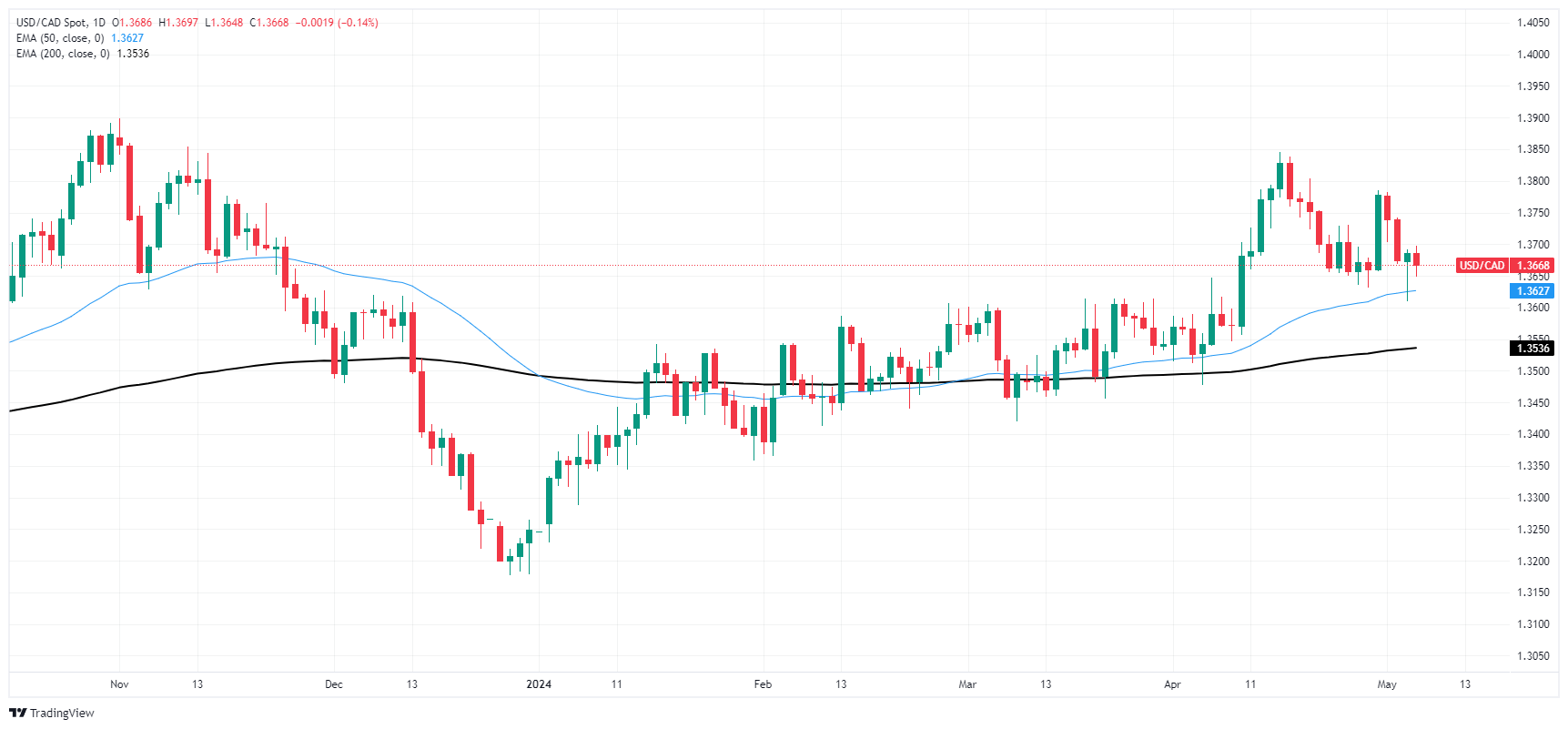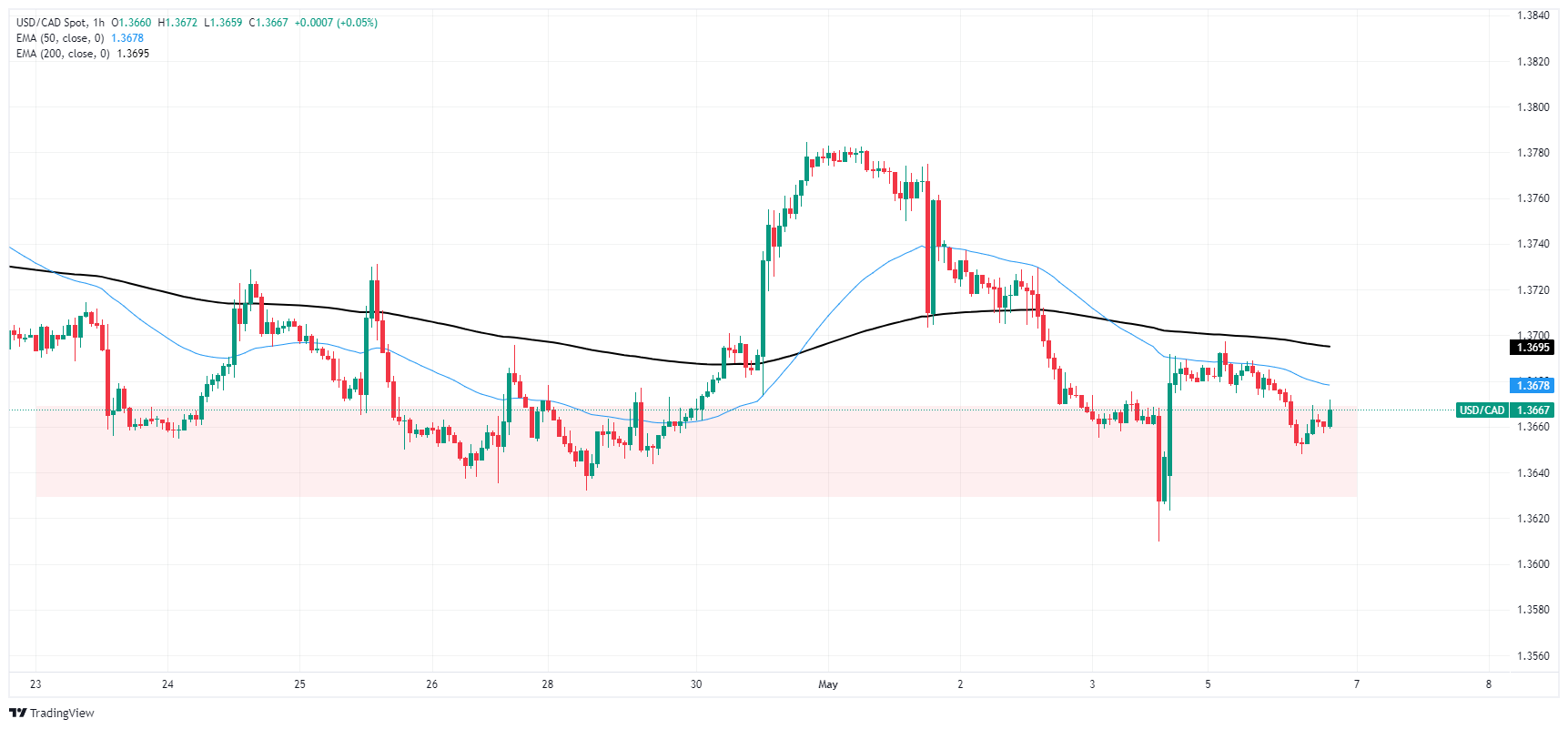- Canadian Dollar moves broadly higher in Monday rebound.
- Canada data is thin until Friday’s labor figures.
- Rate markets put odds of September Fed rate cut at 65%.
The Canadian Dollar (CAD) is experiencing a moderate rebound on Monday, recovering ground that was lost late last week during the risk-off plunge as markets pulled away from the CAD. Markets are kicking off the new trading week on the upside, however, with thin Canadian economic data throughout the week until Friday’s labour report.
Canada will deliver this week’s first CAD data on Tuesday with the Ivey Purchasing Managers Index (PMI) for the month of April. Market reaction will be muted at best with the mid-tier data release, and the rest of the week remains thin with strictly low-tier economic data from Canada until Friday’s Canadian Unemployment Rate and wages data for April.
Daily digest market movers: Canadian Dollar finds some bids on quiet Monday start
- Canadian Dollar recovers ground on Monday as CAD rebounds from Friday’s sell-off.
- Tuesday’s Canadian Ivey PMI (seasonally-adjusted) is expected to climb to 58.1 from 57.5, a 12-month high.
- Friday’s Canadian Unemployment Rate is expected to tick upwards in April to 6.2% from 6.1%.
- With little else of meaningful impact on the data docket this week for either CAD or the US Dollar, looking ahead to better data prints and reactions to headlines is all that’s left for markets.
- According to CME’s FedWatch Tool, rate markets are betting around 65% odds of at least a 25-basis-point cut from the Federal Reserve (Fed) in September.
Canadian Dollar price today
The table below shows the percentage change of Canadian Dollar (CAD) against listed major currencies today. Canadian Dollar was the strongest against the Japanese Yen.
| USD | EUR | GBP | CAD | AUD | JPY | NZD | CHF | |
| USD | -0.09% | -0.15% | -0.17% | -0.19% | 0.25% | -0.03% | 0.06% | |
| EUR | 0.09% | -0.07% | -0.08% | -0.10% | 0.33% | 0.06% | 0.15% | |
| GBP | 0.15% | 0.07% | -0.02% | -0.03% | 0.40% | 0.13% | 0.22% | |
| CAD | 0.18% | 0.09% | 0.02% | -0.01% | 0.44% | 0.14% | 0.23% | |
| AUD | 0.19% | 0.10% | 0.03% | 0.02% | 0.43% | 0.15% | 0.25% | |
| JPY | -0.25% | -0.32% | -0.38% | -0.42% | -0.41% | -0.24% | -0.20% | |
| NZD | 0.03% | -0.05% | -0.12% | -0.13% | -0.15% | 0.28% | 0.09% | |
| CHF | -0.05% | -0.15% | -0.21% | -0.23% | -0.25% | 0.20% | -0.10% |
The heat map shows percentage changes of major currencies against each other. The base currency is picked from the left column, while the quote currency is picked from the top row. For example, if you pick the Euro from the left column and move along the horizontal line to the Japanese Yen, the percentage change displayed in the box will represent EUR (base)/JPY (quote).
Technical analysis: Canadian Dollar pushes back, USD/CAD falls into near-term supply zone
The Canadian Dollar (CAD) is broadly higher on Monday, but gains remain thin. The CAD climbed around a fifth of a percent against the US Dollar (USD), while gaining around four-tenths of a percent against the Japanese Yen (JPY).
USD/CAD has drifted into familiar lows once more, backsliding into a familiar demand zone below 1.3670. The pair is cycling 1.3660 as CAD buying against the US Dollar keeps the pair pinned below the 200-hour Exponential Moving Average (EMA) near 1.3695.
Daily candlesticks leave USD/CAD in slightly more bullish technical shape, trading north of the 200-day EMA at 1.3550. The pair is up 3.1% in 2024 but is still trading on the low side of the YTD peak near 1.3850.
USD/CAD hourly chart
USD/CAD daily chart
Canadian Dollar FAQs
The key factors driving the Canadian Dollar (CAD) are the level of interest rates set by the Bank of Canada (BoC), the price of Oil, Canada’s largest export, the health of its economy, inflation and the Trade Balance, which is the difference between the value of Canada’s exports versus its imports. Other factors include market sentiment – whether investors are taking on more risky assets (risk-on) or seeking safe-havens (risk-off) – with risk-on being CAD-positive. As its largest trading partner, the health of the US economy is also a key factor influencing the Canadian Dollar.
The Bank of Canada (BoC) has a significant influence on the Canadian Dollar by setting the level of interest rates that banks can lend to one another. This influences the level of interest rates for everyone. The main goal of the BoC is to maintain inflation at 1-3% by adjusting interest rates up or down. Relatively higher interest rates tend to be positive for the CAD. The Bank of Canada can also use quantitative easing and tightening to influence credit conditions, with the former CAD-negative and the latter CAD-positive.
The price of Oil is a key factor impacting the value of the Canadian Dollar. Petroleum is Canada’s biggest export, so Oil price tends to have an immediate impact on the CAD value. Generally, if Oil price rises CAD also goes up, as aggregate demand for the currency increases. The opposite is the case if the price of Oil falls. Higher Oil prices also tend to result in a greater likelihood of a positive Trade Balance, which is also supportive of the CAD.
While inflation had always traditionally been thought of as a negative factor for a currency since it lowers the value of money, the opposite has actually been the case in modern times with the relaxation of cross-border capital controls. Higher inflation tends to lead central banks to put up interest rates which attracts more capital inflows from global investors seeking a lucrative place to keep their money. This increases demand for the local currency, which in Canada’s case is the Canadian Dollar.
Macroeconomic data releases gauge the health of the economy and can have an impact on the Canadian Dollar. Indicators such as GDP, Manufacturing and Services PMIs, employment, and consumer sentiment surveys can all influence the direction of the CAD. A strong economy is good for the Canadian Dollar. Not only does it attract more foreign investment but it may encourage the Bank of Canada to put up interest rates, leading to a stronger currency. If economic data is weak, however, the CAD is likely to fall.
Information on these pages contains forward-looking statements that involve risks and uncertainties. Markets and instruments profiled on this page are for informational purposes only and should not in any way come across as a recommendation to buy or sell in these assets. You should do your own thorough research before making any investment decisions. FXStreet does not in any way guarantee that this information is free from mistakes, errors, or material misstatements. It also does not guarantee that this information is of a timely nature. Investing in Open Markets involves a great deal of risk, including the loss of all or a portion of your investment, as well as emotional distress. All risks, losses and costs associated with investing, including total loss of principal, are your responsibility. The views and opinions expressed in this article are those of the authors and do not necessarily reflect the official policy or position of FXStreet nor its advertisers. The author will not be held responsible for information that is found at the end of links posted on this page.
If not otherwise explicitly mentioned in the body of the article, at the time of writing, the author has no position in any stock mentioned in this article and no business relationship with any company mentioned. The author has not received compensation for writing this article, other than from FXStreet.
FXStreet and the author do not provide personalized recommendations. The author makes no representations as to the accuracy, completeness, or suitability of this information. FXStreet and the author will not be liable for any errors, omissions or any losses, injuries or damages arising from this information and its display or use. Errors and omissions excepted.
The author and FXStreet are not registered investment advisors and nothing in this article is intended to be investment advice.
Recommended content
Editors’ Picks
EUR/USD retreats toward 1.0850 on modest USD recovery

EUR/USD stays under modest bearish pressure and trades in negative territory at around 1.0850 after closing modestly lower on Thursday. In the absence of macroeconomic data releases, investors will continue to pay close attention to comments from Federal Reserve officials.
GBP/USD holds above 1.2650 following earlier decline

GBP/USD edges higher after falling to a daily low below 1.2650 in the European session on Friday. The US Dollar holds its ground following the selloff seen after April inflation data and makes it difficult for the pair to extend its rebound. Fed policymakers are scheduled to speak later in the day.
Gold climbs to multi-week highs above $2,400

Gold gathered bullish momentum and touched its highest level in nearly a month above $2,400. Although the benchmark 10-year US yield holds steady at around 4.4%, the cautious market stance supports XAU/USD heading into the weekend.
Chainlink social dominance hits six-month peak as LINK extends gains
-637336005550289133_XtraSmall.jpg)
Chainlink (LINK) social dominance increased sharply on Friday, exceeding levels seen in the past six months, along with the token’s price rally that started on Wednesday.
Week ahead: Flash PMIs, UK and Japan CPIs in focus – RBNZ to hold rates

After cool US CPI, attention shifts to UK and Japanese inflation. Flash PMIs will be watched too amid signs of a rebound in Europe. Fed to stay in the spotlight as plethora of speakers, minutes on tap.